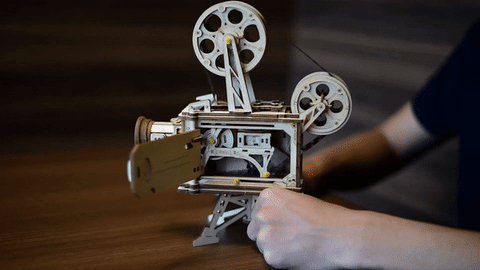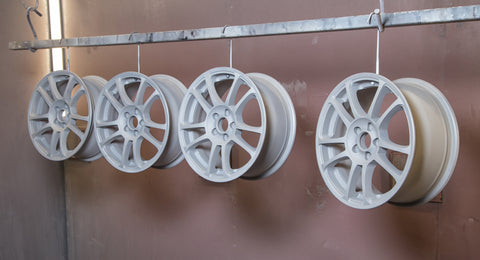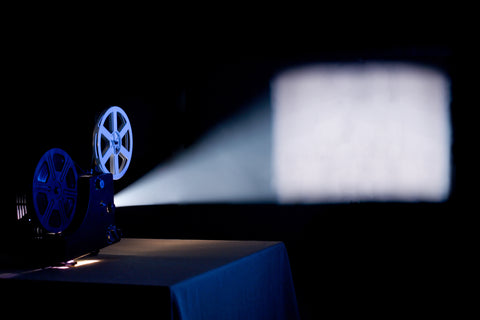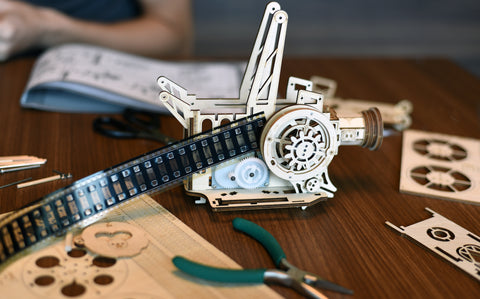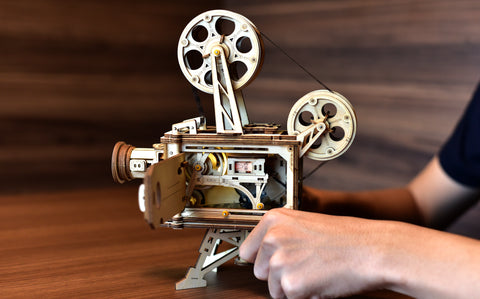We watch videos (also known as motion pictures) every day. It’s hard to avoid seeing one with all the screens around us - from our phones to televisions, and even digital billboards.
So, how was the first motion picture created? And prior to having screen technology, how did we even viewed them in the past?
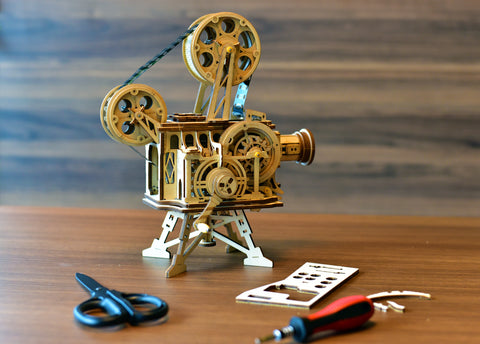
To answer that, we need to understand more about cinematography.
Cinematography is the art and science of making the best out of photography and camera work to produce the right quality for the motion picture being created.
From choosing how the lighting is captured through the lens, to choosing how best to display all the work.
A projector is one of the earliest (read: archaic) methods of viewing motion pictures, and is, in fact, a method that cinemas still use up to today.
Vitascopes are a vital part of the projector history. Let's dive into the history of the projector to understand how Vitascopes are a big part of it.
The Projector's Rich History
The cinematograph created in 1892 was the first ever projector invented for large audiences.
Cinematograph was a term was coined by its inventor Léon Bouly, and literally translates from Greek to mean 'writing in movement'.
However, the first public screening was not to happen until 1895 in Paris. This screening was organised by the Lumière brothers who had bought the rights of the Cinematograph and made further developments to it.
Across in the United States of America, Charles Francis Jenkins developed a projector called a Phantoscope in 1894. In 1895, he worked closely with Thomas J. Armat to improve this device.
These improvements led the inventors to seek patents on their work. However, their partnership came to a bitter dispute regarding the patent rights and split.
Jenkins then made a public demonstration in the late 1895s, however, Armat perfected his version of the kinetoscope and approached the owners of the Kinetoscope Company.
The kinetoscope was designed for viewing a motion picture film one individual frame at a time. William Dickinson designed it during 1889 to 1892 by as an employee of the world renowned Thomas Edison at the time.
After Jenkins sold his share of the joint patent rights to Armat, Armat proposed to Edison to get The Edison Manufacturing Company to manufacture the device and produce its films. Edison agreed on the condition that this device becomes a new Edison invention, and named it the 'Vitascope'.
The Vitascope from The Edison Manufacturing Company finally debuted in 1896 in New York City, and competed against the Lumière Cinématographe's version.
After having gained popularity in 25 U.S. cities, the Vitascope paved the way for further projector developments by the Edison Company in what is now known as the Projectoscope.
FUN FACT: The earliest surviving motion picture created in 1888 is only two seconds long, and is that of a galloping horse.
How it All Works
Let’s take a deeper dive in this section into the technical and engineering aspects of a working Vitascope.
Motion Picture
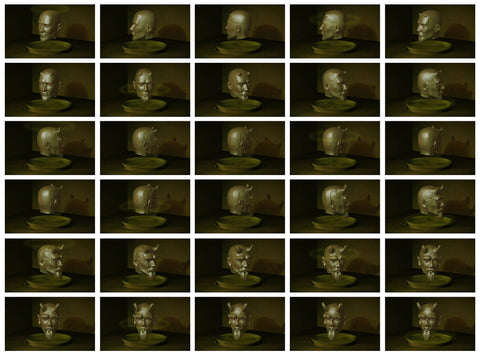
A motion picture is a series of photographs shown to you in quick succession. We consider each photograph as a “frame”, and our human eye begins to perceive this series of photographs as a video between 10 to 12 frames per second (fps).
The reason most cinemas eventually used 24 fps is that it was the minimum tolerable fps to perceive motion. 24 fps is also cost efficient for the entire production of the movie.
24 fps eventually became the standard for the cinematic effect you get in modern cinemas today.
Film
The film itself is how the series of pictures are stored for a movie, and it actually takes a lot of film to store movies!
Films come in different sizes. Different materials are also used to make them as well. The most common print film sizes are of 35mm and 70mm.
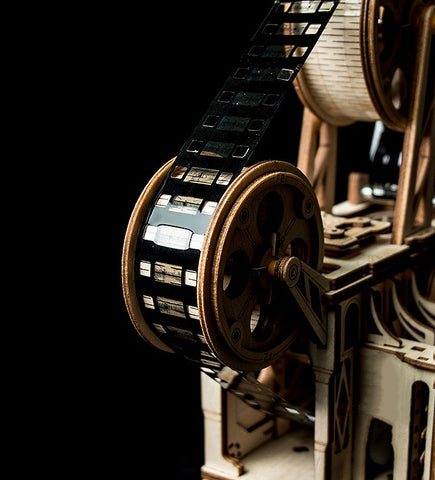
Print film is the film used to print the first work on, and subsequent copies of the final versions once it is edited.
35mm is a popular width for feature films, whereas 70mm is quite popular for widescreen formats like IMAX.
The aspect ratio is the width of a frame divided by its height. Many different aspect ratios are used depending on the country and the usage.
The US for example commonly uses two aspect ratios for 35mm film: 1.85:1 (flat) or 2.40:1 (scope).
Imagine the scale for even one minute of a movie. Using flat 35mm film, a single minute’s worth of film could be as long as 27 meters, or 90 feet!
Our Mechanical Vitascope model uses a 25mm film.
Early adopters in the early days made film using fragile paper roll film. With industry-wide standardization and improvements, celluloid slowly became the material for producing film.
Cellulose nitrate was developed, however this was flammable and a safety hazard, and thus safety film was developed in the 1930s that consisted of cellulose triacetate as the plastic base instead.
Building your own projector
The projector can be segmented down into 4 key assembly stages:
1. Spool assembly
Movies need a huge amount of film. So much so that a movie may be split into five or six different reels of film.
In the early days, a cinema theatre would have two projectors allowing for changeovers to be synchronised across different reels.
In the 1960’s, the technology improved such that large diameter discs stacked vertically could hold all the spliced films together.
As a movie played, one disc passed the film through the projector and spooled onto another disc.
Once a projectionist spliced the films (i.e. carefully taping the end of one strip of film to match the beginning of another), the film would then be loaded onto the feed platter.
The film would also be threaded to the top of the projector through the payout assembly.
A strip of film on either side of it has sprocket holes to allow a sprocket to pull the film through the projector. This can be electrical or hand powered.
The difference between a sprocket and a gear is that whilst a gear (toothed-wheel) turns to transmit movement to another part, a sprocket’s teeth moves a flexible component.
Cambers keep the film in tension to ensure the film does not slip off the sprocket of stick to itself by bunching up.
The claw and crank advances the film at the steady 24 fps needed. This allows for the pauses needed for each frame to be projected onto the screen.
As the film leaves the projector, the film is spooled at the take-up platter after passing through a number of rollers in the payout assembly.
2. Lamp assembly
The light source has since moved away from olden Carbon Arc lamps to Xenon bulbs most commonly used today.
Xenon, a rare gas, works well because it has a long lifespan (thousands of hours), and at higher densities, it conducts electricity easily. This causes it to glow very brightly - great for everyone's viewing pleasure.
A parabolic mirror surrounds the Xenon bulb, reflecting light from it into a condenser.
The condenser consists of paired lenses that intensifies and focuses the light. The heat from the focused light is so hot, it is capable of melting film when spooling by the projector stops.
3. Lens assembly
The shutter, consisting of rotating blades at 24 times per second, blocks the exit of the focused light from the lamp assembly.
This is important as it allows for darkening the transition between frames of the film. Without this blacking out, we'd see a flickering effect of the film during the movie - which is not a very nice viewing experience.
Aperture gates also block out the parts of the film we do not want to see, such as the sprocket holes of the film, and the audio information that is encoded onto the sides of the film.
Another key aspect of the lens is what’s known as the focal length as well as the F-stop number. The natural curved nature of a lens means light coming into the lens is focused at a point a set distance away from the lens.
The bigger the distance, the further away the image feels. The F-stop number expresses the diameter of the lens. The smaller the number, the brighter the image can be as it is able to put through more light.
A calculated balance is required between the lens’ focal length and F-stop number, and with the distance to the screen on display for the audience. Having optimised these numbers, the image projected will be large and clear enough.
Lenses can also come in two types of focal lengths: Fixed (prime lenses) or Variable (zoom lenses). Each type having their own compromise.
Prime lenses allow for a sharper image and works best when there are low light conditions such as cinemas.
Zoom lenses allows for a greater range to be covered, but may result in an image that is not as sharp.
4. Audio assembly
Synchronising sound to the projected film is a dawn of a new revolution in the movie industry. It's also a complexed process - which also explains why it took decades for silent movies to become, well, not silent.
Only as early as 1926 when Warner Brothers developed a commercial with accompanying sound. And thereafter, year 1927 was when we first had dialogue in movies being synchronised with motion picture.
The Modern Cinema
The advancements in the projector technologies has allowed for reducing the number of projectors required to show a film down to one projector per auditorium.

The spool assembly improvements also allowed for this to happen, reducing the workload of the cinema projection crew.
This effectively allowed for multiple auditoriums to be managed with the same amount of effort - paving the way for multiplexes, consisting of 2 to 4 auditoriums simultaneously displaying movies. And soon after, megaplexes consisting of 15 to 20 auditoriums popped up.
Conclusion
While building your own Vitascope, you're essentially reliving the history of Thomas Edison, almost 125 years ago. Get hands-on to truly understand the intricacies of a Vitascope and how its different parts and components interact with one another!
Who knows, perhaps one day your ideas could help to improve the current projector technology, or perhaps, the art and science of all this may inspire you to create your own amazing motion pictures!
Invest in the vision of the Vitascope, just like Edison invested more than a century ago.


